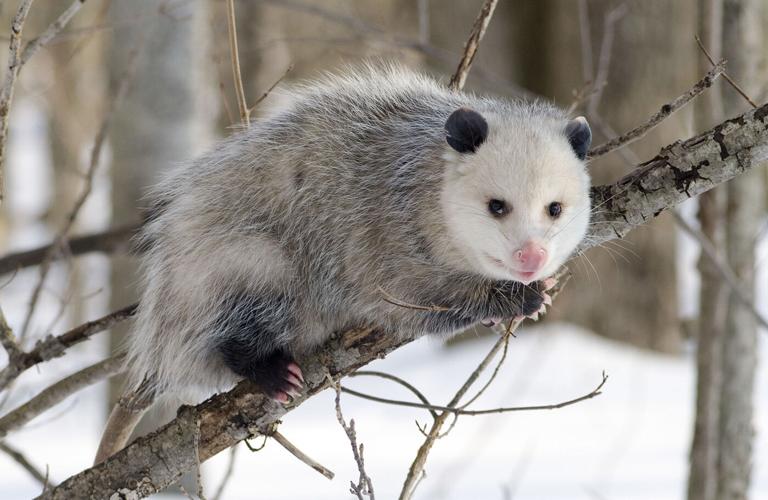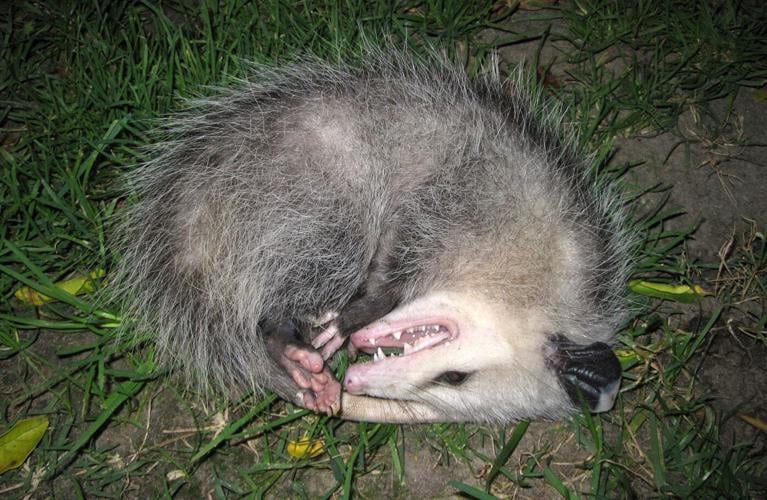
Opossums are adept at climbing trees. Contrary to popular myth, though, they don’t hang from their tails when sleeping. (Cody Pope/CC BY-SA 2.5)
Chances are, you’ve seen an opossum — known by many as a “possum” — in the headlights of your car or at the edge of your yard, startled by the motion-activated floodlight on your back porch. Maybe it stared at you for a moment, its reflective eyes glowing, then skittered away. It’s a fairly common critter in these parts, but it’s anything but ordinary.
F or starters, the animal has a well-known defensive strategy. For most small mammals, the choices are “fight or flight.” But somewhere along the evolutionary path, the opposum came upon a third and often effective option: playing dead. Of course, it’s not a conscious decision on the animal’s part; it’s entirely involuntary, a shocklike state that can last for hours. It often fools would-be predators, particularly those that don’t fancy dead prey.
Playing dead isn’t the animal’s only defense. In some circumstances, it will bare its many sharp teeth when threatened. And the opossum, Didelphis virginiana, is not the only animal to employ what scientists call thanatosis or, more commonly, tonic immobility. The strategy is found throughout the animal kingdom — mammals, insects, amphibians, birds, fish — but the opossum is the best known, hence the expression “playing possum.”

When “fight or flight” won’t work as a defense tactic, the opossum does a convincing job of playing dead. (Tony Alter/CC BY 2.0)
About the size of a large house cat, the opossum is white to gray in color, with a long, round, hairless tail. It has small, round, thin ears, wide jaws with 50 teeth, small black eyes and a long, pointed nose.
Unlike most other animals, opossums have opposable toes, essentially thumbs, on their hind feet. This feature, along with a tail adapted to seizing or grasping, allows them to easily navigate tree branches. Contrary to popular belief, opossums never hang from their tails while sleeping. They are too heavy. Occasionally, a youngster may hang from its tail, but never to sleep.
Oppossums are North America’s only native marsupials. Marsupials are mammals, and in nearly all species the females have a fur-lined abdominal pouch — where, after birth, the young are carried and nourished. Probably the most well-known marsupials are Australia’s kangaroos.
Oppossums are solitary critters, except when breeding. They are nocturnal, wandering at night and sleeping during the day.
Adult females average about two litters a year, with five to 13 babies per litter. Gestation is very brief, only 12–13 days. When born, the tiny young weigh about 2 grams each (well under a tenth of an ounce!) and are only a half-inch long. They are blind, deaf and hairless. The forepaws of the young are well-developed.
Right before birth, the mother prepares a pathway of saliva leading to the pouch. Using their strong forepaws, the young climb from the womb into the mother’s pouch, where they will attach to a nipple and continue to develop, remaining for about two months. In large litters, the babies that do not find an available attachment site will die of starvation.
When fully developed, they emerge from the pouch but remain with their mother until they are 4 months old. Baby possums sometimes ride on their mother’s back, clinging to her fur. The young are preyed upon by owls, coyotes and dogs.
They range from the central states to the East Coast, from the Great Lakes and New England and south from Mexico through Florida. Opossums are also found along the Pacific Coast states. There are other species of Didelphis in Central and South America, but D. virginiana (known as the Virginia or North American possum) is the only one found in the U.S. and Canada.
Highly adaptable creatures, they eat just about anything, including mice, rats, birds, insects, snakes, frogs, vegetables, fruits, worms, slugs, snails, carrion and garbage. Some people refer to them as nature’s little sanitary workers because they consume so many pests and dead animals.
Opossums are also not very particular about where they live. They inhabit woodlands, farmlands and suburbs. They seek shelter in old dens of other animals, outbuildings, barns, hollow trees, logs, culverts and brush piles. So, keep your eyes peeled, especially at night. You never know when you’ll run into North America’s one and only marsupial.


(1) comment
Thank you for writing about the Opossum, a remarkable and much-maligned species. Maybe important to add is that 'possums have a predilection for ticks, consuming large numbers of them. They are survivors, having existed for tens of millions of years. These interesting facts, and those you mention in your article, might encourage people to give 'possums some space and let them live out their lives without interference or persecution!
Welcome to the discussion.
Log In
We aim to provide a forum for fair and open dialogue.
Please use language that is accurate and respectful.
Comments may not include:
* Insults, verbal attacks or degrading statements
* Explicit or vulgar language
* Information that violates a person's right to privacy
* Advertising or solicitations
* Misrepresentation of your identity or affiliation
* Incorrect, fraudulent or misleading content
* Spam or comments that do not pertain to the posted article
We reserve the right to edit or decline comments that do follow these guidelines.